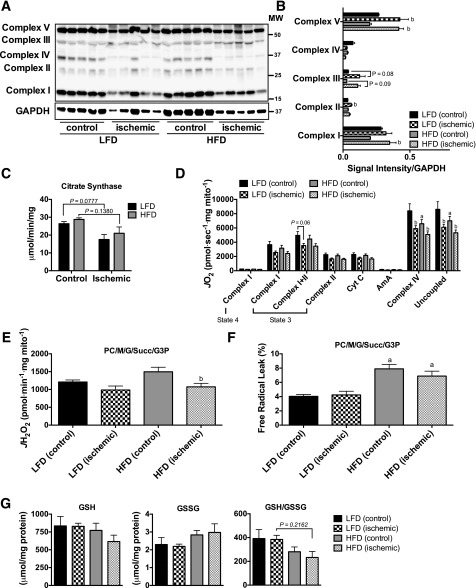Figure 2.
Short-term high-fat feeding does not alter mitochondrial content or respiratory function. A: Western blotting for mitochondrial ETS proteins on control and ischemic limb EDL muscle from HFD and LFD mice (n = 5/group). B: Densitometry of Western blotting shows no diet effects on the abundance of proteins in the ETS. C: Citrate synthase activity was also not different between diets and only marginally lower in ischemic limbs. D: High-resolution respirometry experiments performed on isolated skeletal muscle mitochondria show that the respiratory capacity was similar between HFD and LFD mice (n = 6/group). E: Mitochondrial H2O2 emission under state 4 conditions with 25 μmol palmitoyl carnitine, 10 mmol glutamate, 2 mmol malate, 10 mmol succinate, and 10 mmol glycerol-3-phosphate. F: Free radical leak (%), calculated by normalizing data from E by state 4 JO2 measured in parallel experiments under identical substrate conditions, was greater in HFD mice (n = 6/group). G: GSH, GSSG (oxidized form), and the GSH/GSSG ratio were not statistically different between diets, although muscle from HFD tended to exhibit lower GSH/GSSG (n = 5/group). Data are mean ± SEM and were compared with two-way ANOVA followed by Tukey posttest or two-tailed Student t test. aP < 0.05 for diet effect, bP < 0.05 for ischemia effect. AmA, antimycin A; Complex I(state 3), glutamate + malate + adenosine diphosphate; Complex I(state 4), glutamate + malate; Complex I+II(state 3), glutamate + malate + adenosine diphosphate + succinate; Complex II(state 3), glutamate + malate + adenosine diphosphate + succinate + rotenone; Complex IV, ascorbate + N,N,N',N'-tetramethyl-p-phenylenediamine; Cyt C, cytochrome c; G, glutamate; G3P, glycerol-3-phosphate; M, malate; MW, molecular weight; PC, palmitoyl carnitine; Succ, succinate; Uncoupled, carbonyl cyanide-4-(trifluoromethoxy)phenylhydrazone.

